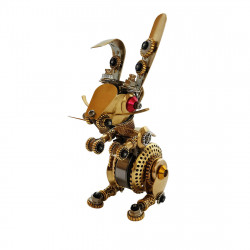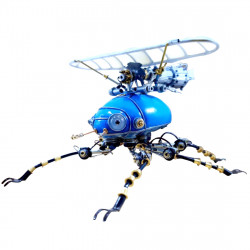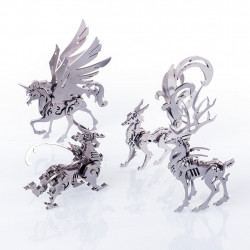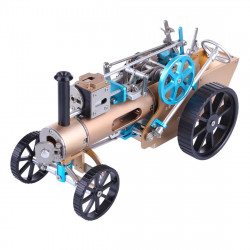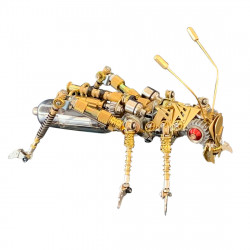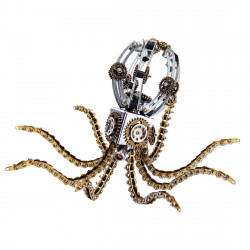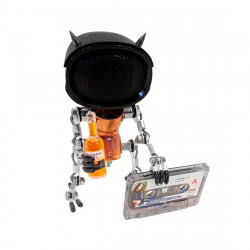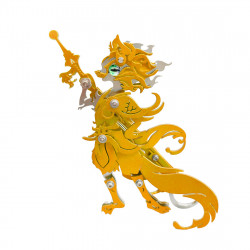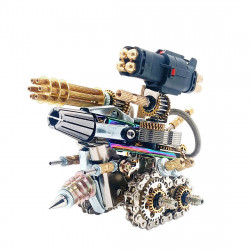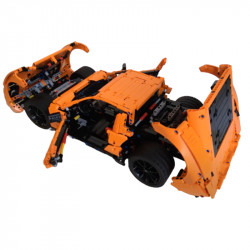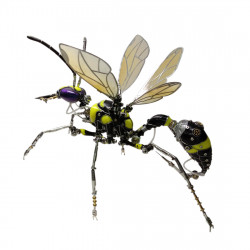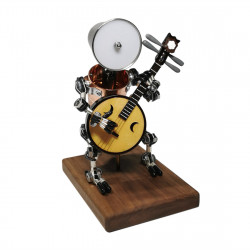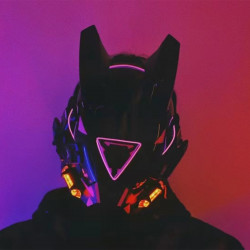Why did Cyberpunk Originate in America but Flourish in Japan?

Why did Cyberpunk Originate in America but Flourish in Japan?
"cyberpunk" refers to a subgenre of science fiction literature that emerged in the 1980s and has since evolved into a distinct aesthetic. Bruce Bethke initially used the phrase " Cyberpunk " in his 1983 science fiction book Cyberpunk. However, William Gibson's Neuromancer in the 1980s popularized Cyberpunk.
These days, punk aspects are becoming more and more prevalent in people's lives, and "cyberpunk" and "steampunk" are ubiquitous. The world isn't stylish at all without the illumination of neon lights. Strongly dystopian and gloomy hues characterize the world of cyberpunk writings in the hazy area between real life and virtual reality. Cyberpunk that has been misused has lost its authentic punk vibe and has evolved into a singular example of appealing to the aesthetics of young people. The mechanical prostheses under the neon lights, the perilous world where AI governs humans, and the awakening and revolt of lonesome hackers typically draw friends new to Cyberpunk. These images have a distinct sharpness, making it sense to draw in viewers.
However, upon closer inspection, you could notice an oddity: why are Japanese themes in every cyberpunk piece? For instance, the hacker escapes death and finds a stall to eat ramen; the mechanical girl unexpectedly draws a samurai sword. People who view these images too frequently will question why the cyberpunk worldview does not incorporate more Japanese aspects. Cyberpunk can be described as a unique kind of chowder. The odd Japanese and Asian components have become indispensable flavouring agents. Neon lights, haze, mind control, artificial intelligence, urban jungle, mechanical prosthetics, virtual reality, and the deprivation of human beings by large companies are all necessary components. What is the origin of this "recipe"? This dates back to the early days of Cyberpunk.
Why Japan is a popular place for Cyberpunk: Cyberpunk—a subgenre of science fiction that centres on sophisticated science and technology in a dystopian future—has become increasingly popular in Japan.
One explanation is that cyberpunk concepts and aesthetics mesh nicely with Japan's lengthy science fiction literature and media history. Themes of virtual reality, artificial intelligence, and the relationship between technology and society—all prevalent in cyberpunk literature—have been frequently examined in Japanese science fiction.
Furthermore, Japan has a reputation as a pioneer in creating and using cutting-edge technologies and is home to several significant technology corporations. Given that the genre frequently depicts a future in which technology plays a major part in society, this has helped explain why Cyberpunk has become so popular in Japan.
Lastly, the presentation of Cyberpunk in Japanese media has been impacted by Japan's distinct culture and visual sensibility. As a result, "Japanese cyberpunk," a unique subgenre of Cyberpunk, has emerged, fusing traditional cyberpunk themes with aspects of Japanese society and aesthetics.
Japan's strong science fiction heritage, its position as a technological leader, and its distinct cultural influences all contribute to the popularity of Cyberpunk there.
1. The global cultural influence of the 1980s
The idea that technology instils concepts and skills in people before taking over is a persistent theme in the cyberpunk universe. Additionally, Japan, a strange nation, deftly inserted its own cultural will into the development of Cyberpunk.
Three musicians, Hosono Harutomi, Takahashi Yukihiro, and Sakamoto Ryuichi, made up the popular band YMO in the late 1970s and early 1980s. They combined psychedelic and electronic influences with punk music inherited from the UK. The expression of the distinct idea of "music magic of the yellow race" has astonished the music communities in both Europe and America. The technology boom that was starting in Japan at the time served as a significant source of inspiration for the establishment of YMO. The national fervour for computers, bionics, and robotics has produced a distinct technocracy. This mood was brought to Europe and the US through music, comics, films, and other media, creating a cultural conflict that went beyond the US-Japan economic and technological rivalry. In his works, William Gibson, greatly influenced by Japanese culture and YMO music, conveyed his knowledge of Japanese culture and his apprehension about Japanese technology. The board game "Cyberpunk" emerged in 1988 and heavily referenced William Gibson's concepts and visuals. The original intellectual property of "Cyberpunk 2077" is this board game worldview, which shows the fall of the US government, the emergence of big businesses, and the Japanese corporation Arasaka completely conquering the US.
Takemura paid homage to the opening chapter of "Neuromancer" called "Sad Chiba City" in "Cyberpunk 2077" by stating that his hometown is in Chiba, Japan. In the 1980s, Japan's most advanced foreign trade and most concentrated technology industry were found in Chiba City, Tokyo's sea estuary. It was envisioned by authors as a symbol of Japanese-style gloomy night cities and technical jungles, maybe due to its frequent appearance in worldwide news, and it later oddly became a "sacred place" for cyberpunk fans.
2. The Birth of a Dystopian Mood
By illustrating the decadent dilemma of "high-tech and low life" following the over-development of technology in the future world, Cyberpunk aims to provoke reflection on the negative aspects of technology and its interaction with humans. Instead of a categorical rejection and hostility to technology, this dystopian thinking is characterized by ambiguity and melancholy. From form to substance to subject, Cyberpunk has a very cohesive sci-fi aesthetic system.
A growing number of cyberpunk films depict humans as being made by robots that "plant" them like potatoes, so objectifying and enslaving them. Most people are unaware of the world's reality because of the flawless illusion of the maternal world. Like us, they work and live in stages. But no matter how good the machine is, it will break down, and no matter how good the system is, there will be flaws—the matrix bugs, that is, the bugs that have been identified by a few people who have begun to revolt against this virtual reality.
It indicates that in addition to learning about the truth, goodness, and beauty of human nature, the machine has also learnt about its false, bad, and ugly aspects. When the two extremes of human nature are merged, human civilization and machine civilization can agree.
During that period, the post-Cold War era was engulfing the Western world. The economic crisis and the Cold War's aftermath sowed intense pessimism and dystopian attitudes on the soil of widespread uneasiness and concern. Japan's success has forced the West to reconsider the far-off Eastern culture. "A significant idea evident in Western science fiction since the late 1970s is that Japan is the future. The strange culture of Japan portends an uncertain future. According to Anna Lee Newitz (Annalee Newitz), an American cyberpunk author.
The construction of the cyberpunk world is frequently filled with various intriguing oppositions due to the strong cultural contrast between Eastern and Western cultures. These include the opposition between individuals and totalitarian organizations, between advanced and broken technology, between flesh and blood, between steel and iron, and so forth. "High Tech Low Life" is the epicentre of Cyberpunk. According to author Bruce Sterling, Cyberpunk is "Treat people like rats, and all measures against rats can be imposed on people equally." As a result, technology and individualism have always been central to Bopunk stories.
This is precisely what makes Cyberpunk so appealing. It enables us to reflect on the present and make thoughtful decisions about responding to technological advancement. Yet, it offers a range of options rather than a definitive response, ensuring you always have the freedom to make your own decisions.
3. The golden age of Japanese cyberspace is coming
The efforts of Japanese animation artists have played a significant role in the emergence of the golden age of Japanese online. Additionally, these "human nature" artists received much support from Japanese society in the 1980s, particularly from the country's technology sector.
With a total investment of 100 billion yen, Japan stated in October 1981 that it was beginning the development of the fifth-generation computer, which it said would be a significant advancement in the history of human computers. This tragedy, which naturally caused hundreds of waves in Japan, was dubbed "Pearl Harbor in the technological world" by the American media at the time. In a society where high technology dominates human beings, fear and bewilderment appear to be in the making, especially when combined with Japan's success in several areas like robotics, bionic technology, and semiconductors. Robots and artificial intelligence are on the horizon, and large corporations will watch everything. At that time, the Japanese cultural circle was full of many fantasies. Then, in conjunction with the Japanese culture's propensity for surprise and death, several hardcore Japanese cyberpunks emerged.
Sakyo Komatsu's 1973 novel "The Sinking of Japan" revealed the threat of nuclear war and the destructive power of technology. The cross-generational animated film "Akira" was released in 1988. Katsuhiro Otomo's philosophical conjectures and profound concerns regarding the rapid advancement of technology were mirrored in the topic of the post-nuclear metropolis and technology taking over human nature.
The "Ghost in the Shell" serialization started in 1989, and the geek filmmaker Oshii Mamoru brought it to the big screen in 1995. This well-known work covers various subjects, including souls, artificial intelligence, mechanical prostheses, and electronic brains. Nothing that could be considered Cyberpunk is overlooked. It has achieved the golden age of Japanese Cyberpunk. Along with ethereal and enigmatic Japanese-style music, writing, and screen emotions, it has become an indisputable milestone in the field of Cyberpunk.
These odd expressions, which completely incorporated electronic fear, wasteland fear, and centralization panic into animation works, were a huge hit during that unique time. Later, they became the original cyberpunk classics that made their way into video games and motion pictures. This was all in tandem with the rapid development of Japanese animation.
These exaggerated three-dimensional urban features—horizontal or vertical—as well as the disorganized and excessive growth, the fine-grained division of labour and organization, and the economic and cultural separation between people—are additional spectacles that serve as cyberpunk sources of inspiration for the city.
4. Color Visual Conceptual
In terms of appearance, cyberpunk-like cities are mostly cool, integrating modernism (air vehicles), artificial landscapes (tall buildings, a variety of architectural designs), city lights (LED displays, neon ads), and other aspects in one. Japan is the cyberpunk world that the authors long for because of all of these factors.
Tokyo is characterized by its dense population, small land area, and massive skyscrapers surrounding it like a modern machine operating at high speed. However, Tokyo's urban construction adheres to demanding industrial and mechanical design standards, giving the city the appearance of an urban steel jungle. Emotion as the throng of people dashes through the city jungle. People will naturally experience psychological strain from such visual effects, and they also virtually embody the essence of Cyberpunk.
Japan at night is more consistent with the design of the cyberpunk world. Tokyo is an entirely different place at night when the neon lights and closely spaced signboard lights on the street are illuminated. Because of the congested traffic, winding streets, and numerous neon signs, it feels as though people live in a city made of signs.
The government imposes stringent rules on the design of Japanese-style signboards placed across the city. According to government requirements, the designer must saturate the signboard's colour matching and the luminous degree of the lightbox after designing the brand's name and information. Modification. When numerous signboards are placed on the street, these requirements allow them to maintain the distinctive features of their brands and are easily recognizable due to their consistent brightness.
The tiny, user-friendly store sign lights, flickering and mixing in the dense urban jungle, appear to be the actual cyberpunk world in the metropolitan area where every square inch of land is costly. Neon lights are, of course, the most thrilling aspect of Cyberpunk. It was once the most opulent illumination imaginable. Still, as time went on, the neon lights that emerged in the filthy bars and the sidewalk sex businesses came to represent the seedy city. It's common to equate the candy-flavoured lights with terms like "psychedelic" and "nothingness." Androgynous lighting is often used while designing a cyberpunk setting. This is because two-colour illumination is an entirely optical illusion produced by technology and does not exist in nature, which is apparent to the unaided eye. As a result, pink, blue, and purple are frequently used in science fiction movies. Neon lights are numerous and dense, especially at night. They render and weave together until they engulf all the original blacks and leave their colours behind. People's perplexity between the old and modern centuries is satisfied by neon.
5. Eastern Shadows
The conflict between nations and the growth of globalization, two inherently incompatible phenomena, have often turned into cultural hotspots when we look back at the subcultural circle following World War II. Many works of science fiction, espionage wars, and ideology-related literature emerged in the 1960s and 1970s due to the Cold War's Iron Curtain and the U.S.-Soviet struggle for hegemony. Many of them have been passed down to this day, but they no longer bear the marks of the times. The 1980s saw the emergence of Japan's economy, technology, and international firms, which also supplied this strange and paradoxical "cultural impetus." At the time, cultural circles in Europe and America were afraid of Japan's dominance of the world economy and the failure of technological competition. Japanese multinational corporations expanded into every facet of electronics, household appliances, and vehicles during the period of economic stagflation that the United States was experiencing. An ordinary "Japanese tax" exacerbates this psychological collapse.
A carnival and alienation psychology that technology will erupt comprehensively is firmly ingrained in the minds of Japanese inventors. After people started viewing everything through the lens of technological advancement, there were fears and predictions regarding robots, artificial intelligence, and electronic biology.
Because these two feelings are entwined, Cyberpunk can acquire acknowledgement from technology rivals and societal consensus. These themes—high technology, low living, and humans being dominated by society and technology—have emerged as the evident legacy of the technological explosion age. The Kowloon Walled City in Hong Kong, China, is the most prevalent example of an oriental aspect in Cyberpunk, aside from Japanese characteristics. With the backdrop of worldwide technological rivalry, the imagination of people living in filthy nooks of the busy metropolis, squished by buildings and trapped by neon lights, has grown even more. A "projector" is what the Kowloon Walled City has become.
The alienation of Orientalism from a Western viewpoint, the intense fear of human high-tech gone wrong, and the social apathy engendered by the vast city are all characteristics of Cyberpunk that are Japanese in origin. Western writers are adamant that Japan will eventually take this course, and many Japanese people are persuaded. Unfortunately, scientific and technological advancements are not as frightening, but the economic bubble burst is horrible.
The future cities portrayed in cyberpunk science fiction films serve more as a "mirror" than as prophecies or obvious clues to the present towns. The source of this cultural success is the society's vivid vision of the city and its fate, which is mirrored in this mirror. Consider it from a different perspective. Our current time quadrant encompasses several factors: post-epidemic, Sino-US technical competitiveness, entertainment globalization, and new energy transformation. In actuality, it's a great cultural hub.


